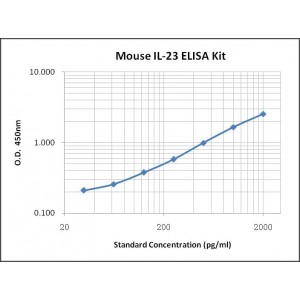More info
Assay Range | 31.2-2,000 pg/mL |
Sensitivity | 2.0 pg/mL |
Specificity | No cross-reaction with other related substances detected |
Size | 96T |
Storage | Store at 2 - 8ºC. Keep reconstituted standard and detection Ab at -20 ºC |
Assay Principle | Sandwich ELISA |
Sample Volume | 100 µL final volume, dilution factor varies on samples |
Sample Type | serum, plasma or cell culture supernatant |
Detection Method | Chromogenic |
Kit Components
1. Recombinant Mouse IL-23 standard: 2 vials
2. One 96-well plate coated with Mouse IL-23 Ab
3. Sample diluent buffer: 12 mL - 1
4. Detection antibody: 130 µL, dilution 1:100
5. Streptavidin-HRP: 130 µL, dilution 1:100
6. Antibody diluent buffer: 12 mL x1
7. Streptavidin-HRP diluent buffer: 12 mL x1
8. TMB developing agent: 10 mL x1
9. Stop solution: 10 mL x1
10. Washing solution (20x): 25 mL x1
Background
Interleukin-23 (IL-23), is a heterodimeric cytokine composed of an IL-12p40 (IL-12β) subunit that is shared with IL-12 and the IL-23p19 subunit. The mouse p19 is synthesized as a 196 amino acid (aa) precursor with a putative 21 aa signal peptide and 175 aa mature protein which is structurally similar to the IL-6 family and to the p35 subunit of IL-12. The mouse p40 cDNA encodes a 335 aa precursor with a putative 22 aa signal peptide and 313 aa mature protein that contains four potential glycosylation sites, a C2-type immunoglobulin domain and a fibronectin type III domain. Mature mouse p19 and p40 share 88% and 92% aa sequence identity with rat counterparts, respectively. IL-23 is produced by activated macrophages, microglia, and monocyte-derived dendritic cells in response to pathogens including certain bacteria and viruses.
IL-23 elicits ifs effects by interacting with the IL-23 receptor complex of two receptor subunits, the IL-12 receptor β1 subunit (IL-12 Rβ1) and the IL-23-specific receptor subunit (IL-23R). The IL-23 receptor complex is expressed in mouse Th1 and Th2 cells, bone marrow dendritic cells, IFN-γ-activated macrophages, and CD4+ CD45RBlow memory T cells. IL-23 binds to IL-12 Rβ1, but the IL-23 R subunit is required for signal transduction. IL-23 and IL-12 exhibits overlapping and distinct biological activities. The IL-23 immune pathway induces the earliest recruitment of neutrophils to the site of infection, while the more classic host defense and cytotoxic response is stimulated by IL-12. IL-23 has a role in the development and maintenance of a T cell subset, designated Th17, that is characterized by the production of IL-17A, IL-17F, IL-6, and TNF-a. The induction of Th17 cells involves the actions of TGF-β, while their survival and expansion appears to be IL-23-dependent. The IL-23/IL-17 axis is an important mediator of inflammation. In mouse models, overexpression of IL-23 leads to a lethal systemic inflammatory response. IL-23 effects on Th17 cells may also enhance the development of several models of autoimmune disease including experimental allergic encephalomyelitis (EAE), collagen induced arthritis (CIA), colitis, and diabetes.


